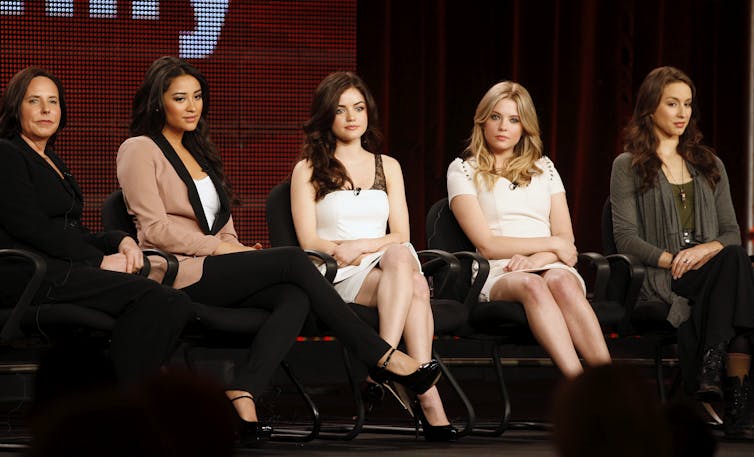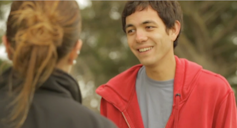From 'Pretty Little Liars' to 'The OC,' television producers need to stop encouraging teen drinking – here's how they can
- Written by Cristel Antonia Russell, Professor of Marketing, American University Kogod School of Business
Teen drinking is rampant on television these days.
From “Pretty Little Liars[1]” to classic shows like “The O.C.[2],” you don’t have to look hard to find 16-year-olds sneaking a drink from a flask or getting drunk at a party.
The problem is that as teens see their favorite characters[3] having a beer on TV, they’re more likely to have one themselves.
The majority of TV shows teens watch depict characters drinking alcohol[4], often heavily, with few negative consequences. Sometimes, alcohol brands that appear are placed there purposefully by alcohol companies[5].
Alcohol companies are prohibited from advertising their products to teenagers on billboard near schools or buying commercial time during programs in which the majority of the audience is under 21. But there isn’t an explicit ban on paying to have their brand[6] appear in a television show. This practice is called product placement.
As a researcher of media influences, I became alarmed about what seemed to be a loophole in regulation[7]. Based on my own research[8], I knew that the more viewers immersed themselves in a show’s narrative, the more they’re likely to be influenced by what it portrays.
In a recent study, I found that teens are particularly susceptible to this effect because they can easily develop a connection[9] to characters with whom they identify.
My research[10] with marketing and[11] public health[12] colleagues shows[13] that even a single episode shapes viewers’ beliefs about drinking, drinkers and their own intentions to drink.
So how can producers counter this effect?
 ‘Pretty Little Liars’ is one of many shows that depict teen drinking in a positive way.
Reuters/Fred Prouser[14]
‘Pretty Little Liars’ is one of many shows that depict teen drinking in a positive way.
Reuters/Fred Prouser[14]
Ineffective regulation
In the United States, alcohol promotion is largely regulated through voluntary industry marketing codes[15]. These codes forbid alcohol advertising in media, including digital media, where 28% of the projected audience is under 21.
In the absence of independent oversight[16], alcohol companies have long realized that product placement provides a relatively easy way to get around these regulations, to the increasing worry of consumer advocates[17].
Alcohol is one of the most actively placed product categories[18] in Hollywood TV programs and movies. The growth of product placement consistently outpaces that of traditional advertising.
In a broader program of research on viewers’ feeling of connectedness[19] to a TV series, my colleagues and I found strong evidence that TV characters’ diets, clothes and even dialect influence viewers, especially when they connect to the characters as if they were real.
Across many studies in different countries and across different TV genres, I found evidence that the emotional connections viewers feel to television characters affects their real life behaviors. Audiences want to be like the “friends”[20] they see on TV.
These powerful influences have fueled the practice of product placement – in this case, of alcohol – and its success.
Making a TV show
I wanted to figure out if there was a way to counteract this effect. With funding from the National Institute on Alcohol Abuse and Alcoholism, I created my own TV episodes.
I wrote the script, collaborated with film and theater students at San Francisco State University, professionally edited the videos and even dubbed the shows in French for conducting studies in France, too.
The experiment consisted of 18-minute, professional-quality TV episodes about Tom, a high school student. Tom and his friends drink at a party, which gives Tom the confidence to approach and kiss Katie, his romantic interest.
We used these TV episodes in a series of studies. Participants who agreed to give feedback on a TV pilot – that’s how we presented the research study to them – would watch one version of the episode and then answer questions about the story, characters and degree to which they were transported into the story.
After the episode, we also measured beliefs about the consequences of drinking, attitudes toward drinkers and intentions to drink in the future.
 Tom is a character from the author’s TV episodes who experiences positive consequences after drinking.
Author provided
Tom is a character from the author’s TV episodes who experiences positive consequences after drinking.
Author provided
In one version, we included warnings before the episode stating[21] that alcohol products were advertised inside the TV episode. But the viewers who were most immersed in the story and its characters, as measured by their levels of reported “connectedness[22],” were immune to the warning.
Immersive epilogues
We also filmed epilogues that featured the main character correcting the pro-drinking message in the story.
Half the participants saw the epilogue in which a main character talked directly to the camera to say: “What you see on TV is not real. You do not need to drink to look cool and fit in.” The other half saw the episode without an epilogue.
Though viewers who were immersed in the pro-alcohol storyline reported more favorable attitudes toward drinkers and higher drinking intentions following the episode, we also found a hopeful outcome.
The epilogue was able to correct this influence, but only for viewers who were aware that they were being persuaded to buy a product. In other words, the epilogue had the most corrective power for those viewers who were both transported by the story and recognized someone was selling them something.
The author studied ‘That 70s Show’ in one of her earlier studies.Getting savvy
So what does this all mean?
Just as marketers have recognized and embraced that today’s teens are naturally savvy about marketing efforts, so should public health campaign developers.
Today’s teens are growing up with branded content and product placement. They recognize it when they see it. So, get savvy with them: Let them enjoy and get immersed in the stories they watch, but remind them that what they’re watching is in fact fictional – and so are the consequences the characters face.
References
- ^ Pretty Little Liars (www.imdb.com)
- ^ The O.C. (www.imdb.com)
- ^ favorite characters (www.hbo.com)
- ^ TV shows teens watch depict characters drinking alcohol (www.ncbi.nlm.nih.gov)
- ^ placed there purposefully by alcohol companies (www.ncbi.nlm.nih.gov)
- ^ their brand (www.ftc.gov)
- ^ loophole in regulation (www.camy.org)
- ^ research (www.doi.org)
- ^ a connection (www.doi.org)
- ^ My research (www.doi.org)
- ^ with marketing and (vcresearch.berkeley.edu)
- ^ public health (www.usuhs.edu)
- ^ colleagues shows (www.hofstra.edu)
- ^ Reuters/Fred Prouser (pictures.reuters.com)
- ^ voluntary industry marketing codes (www.distilledspirits.org)
- ^ absence of independent oversight (www.camy.org)
- ^ consumer advocates (pediatrics.aappublications.org)
- ^ most actively placed product categories (doi.org)
- ^ connectedness (doi.org)
- ^ want to be like the “friends” (doi.org)
- ^ included warnings before the episode stating (doi.org)
- ^ connectedness (doi.org)
Authors: Cristel Antonia Russell, Professor of Marketing, American University Kogod School of Business

